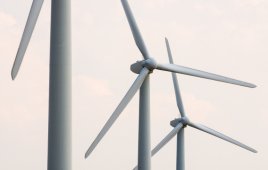 Currently, a major focus of OEMs is designing turbines that actually last 20 years. As their reliability increases, maintenance costs and downtime decreases. More than 50% of the national fleet is out of OEM warranty and that figure can only rise.
Currently, a major focus of OEMs is designing turbines that actually last 20 years. As their reliability increases, maintenance costs and downtime decreases. More than 50% of the national fleet is out of OEM warranty and that figure can only rise.
The last decade saw a boom in newly installed turbines. These units have relatively low maintenance costs, regardless of who’s footing the bill, and relatively high availability. However, looking at the lifecycle for a turbine shows that operations and maintenance costs for wind power typically double or triple projected costs. To correct this oversight manufacturers have begun offering extended service warranties, some as long as 10 years.
Project owners range from community-owned one-offs to Fortune 100-owned and power-market focused projects. As such, each owner requires different services from the manufacturer. At the other end of the spectrum, a large-scale project owner such as NextEra Energy or MidAmerican Energy Holdings is better off sourcing its own maintenance contracts. This is where independent service providers add value to a project. The largest operators have the in-house engineering and support functions to manage projects with 3rd-party service providers or even provide those O&M services in-house. The smallest owner operators may want to employ 3rd-party O&M services, but do have these support functions available. Some 3rd-party providers are now offering these support functions for supply chain, engineering, and predictive maintenances.
Beyond the who-pays-for-what predicament now prevalent in the wind industry, predictive and preventative processes have become more common over the last couple of years. Predictive maintenance, condition monitoring (CME) in one form, can provide a substantial boost to turbine availability. CME quickly pays for itself by avoiding catastrophic failures and allowing uptower gearbox and generator repairs, instead of main component change outs.
Condition monitoring is a way to keep tabs on power-production equipment mounted on 60 to 100-m towers and often on wind farms in remote locations – not the easiest power plants to check. Condition monitoring equipment assists by placing vibration sensors on main bearings, gearboxes, and generators. The sensors transmit vibration signals to a monitoring station. Thanks to the Internet, this station could be many miles away. People monitoring the turbines could be responsible for several wind farms. After the vibration signals trend for a few months, it’s possible to tell where trouble is brewing.
Analysis software that assists with turbine monitoring, Fast-Fourier Transforms, can associate a frequency with a vibration so it’s possible to nearly pinpoint an ailing component. Knowing the general speed of a component, say a 300-rpm bearing in the second stage of a gearbox, it’s possible to spot its vibration amplitudes. Because bearings generally do not fail catastrophically, the vibration amplitude can be tracked as it rises, and the bearing scheduled for replacement at the O&M crew’s “convenience” and not as a surprise. WPE
Filed Under: Featured, O&M




Do you incorporate into the design any fluid monitoring, as we have a fluid properties sensor, which offers real-time monitoring of multiple parameters of fluids. This multi-function sensor immersed in the fluid monitors viscosity, density, dielectric constant and temperature. This monitoring will mean that fluid change intervals can be optimised, allowing full-life use for maximum economy, without the risks associated with deteriorating characteristics. This sensor can be used with fuels, lubricating oils, coolants and hydraulic fluids across many applications.
I would be interested to see what sensors are already used?
Glenn